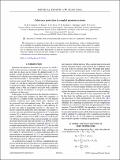Files in this item
Coherence protection in coupled quantum systems
Item metadata
| dc.contributor.author | Cammack, Helen Mary | |
| dc.contributor.author | Kirton, Peter George | |
| dc.contributor.author | Stace, Thomas | |
| dc.contributor.author | Eastham, Paul | |
| dc.contributor.author | Keeling, Jonathan Mark James | |
| dc.contributor.author | Lovett, Brendon William | |
| dc.date.accessioned | 2018-01-23T13:30:05Z | |
| dc.date.available | 2018-01-23T13:30:05Z | |
| dc.date.issued | 2018-02 | |
| dc.identifier | 252108600 | |
| dc.identifier | 212d2a78-5b11-47c8-a684-f17c2343d4b5 | |
| dc.identifier | 85042066412 | |
| dc.identifier | 000424055400002 | |
| dc.identifier.citation | Cammack , H M , Kirton , P G , Stace , T , Eastham , P , Keeling , J M J & Lovett , B W 2018 , ' Coherence protection in coupled quantum systems ' , Physical Review. A, Atomic, molecular, and optical physics , vol. 97 , no. 2 , 022103 . https://doi.org/10.1103/PhysRevA.97.022103 | en |
| dc.identifier.issn | 1050-2947 | |
| dc.identifier.other | ORCID: /0000-0002-4283-552X/work/41304420 | |
| dc.identifier.other | ORCID: /0000-0001-5142-9585/work/47136546 | |
| dc.identifier.uri | https://hdl.handle.net/10023/12588 | |
| dc.description | HMC acknowledges studentship funding from EPSRC under grant no. EP/G03673X/1. PGK acknowledges support from EPSRC (EP/M010910/1). BWL acknowledges support from EPSRC (EP/K025562/1). PRE acknowledges funding from SFI (15/IACA/3402). JK acknowledges financial support from EPSRC programs “TOPNES” (EP/I031014/1) and “Hybrid-Polaritonics” (EP/M025330/1). | en |
| dc.description.abstract | The interaction of a quantum system with its environment causes decoherence, setting a fundamental limit on its suitability for quantum information processing. However, we show that if the system consists of coupled parts with different internal energy scales then the interaction of one part with a thermal bath need not lead to loss of coherence from the other. Remarkably, we find that the protected part can remain coherent for longer when the coupling to the bath becomes stronger or the temperature is raised. Our theory will enable the design of decoherence-resistant hybrid quantum computers. | |
| dc.format.extent | 7 | |
| dc.format.extent | 497613 | |
| dc.language.iso | eng | |
| dc.relation.ispartof | Physical Review. A, Atomic, molecular, and optical physics | en |
| dc.rights | Copyright © 2018, American Physical Society. This work has been made available online in accordance with the publisher’s policies. This is the final published version of the work, which was originally published at https://doi.org/10.1103/PhysRevA.97.022103 | en |
| dc.subject | QA75 Electronic computers. Computer science | en |
| dc.subject | QC Physics | en |
| dc.subject | TK Electrical engineering. Electronics Nuclear engineering | en |
| dc.subject | DAS | en |
| dc.subject.lcc | QA75 | en |
| dc.subject.lcc | QC | en |
| dc.subject.lcc | TK | en |
| dc.title | Coherence protection in coupled quantum systems | en |
| dc.type | Journal article | en |
| dc.contributor.sponsor | EPSRC | en |
| dc.contributor.sponsor | EPSRC | en |
| dc.contributor.sponsor | EPSRC | en |
| dc.contributor.institution | University of St Andrews.School of Physics and Astronomy | en |
| dc.contributor.institution | University of St Andrews.Condensed Matter Physics | en |
| dc.identifier.doi | 10.1103/PhysRevA.97.022103 | |
| dc.description.status | Peer reviewed | en |
| dc.identifier.grantnumber | EP/M010910/1 | en |
| dc.identifier.grantnumber | EP/I031014/1 | en |
| dc.identifier.grantnumber | EP/M025330/1 | en |
This item appears in the following Collection(s)
Items in the St Andrews Research Repository are protected by copyright, with all rights reserved, unless otherwise indicated.

